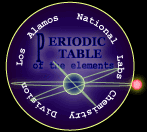

| Atomic Number: | 77 |
Atomic Radius: | 135.7 pm | ||
| Atomic Symbol: | Ir |
Melting Point: | 2446 �C | ||
| Atomic Weight: | 192.22 |
Boiling Point: | 4428 �C | ||
| Electron Configuration: |
[Xe]6s24f145d7 |
Oxidation States: | 3, 4 |
(L. iris: rainbow) Tennant discovered iridium in 1803 in the residue left when crude platinum is dissolved by aqua regia. The name iridium is appropriate because its salts are highly colored.
Iridium, a metal of the platinum family, is white (similar to platinum) but with a slight yellowish cast. Because iridium is very hard and brittle, it is hard to machine, form, or work.
It is the most corrosion-resistant metal known, and was used in making the standard meter bar of Paris, which is a 90 percent platinum and 10 percent iridium alloy. This meter bar was replaced in 1960 as a fundamental unit of length (see Krypton).
Iridium is not attacked by any of the acids nor by aqua regia, but is attacked by molten salts, such as NaCl and NaCN. The specific gravity of iridium is to osmium's specific gravity. Calculations of the densities of iridium and osmium from the space lattices give values of 22.65 and 22.61 g/cm^3, respectively. These values may be more reliable than actual physical measurements for determining which element is heavier.
Iridium occurs uncombined in nature with platinum and other metals of this family in alluvial deposits. It is recovered as a by-product from the nickel mining industry.
Although its principal use is as a hardening agent for platinum, iridium is also used to make crucibles and devices requiring high temperatures. It is also used for electrical contacts.
The element forms an alloy with osmium which is used for tipping pens and compass bearings.
Iridium costs about $500/troy ounce (as of 1990).
Title Picture: Asteroid. The PT Boundry contains large amounts of iridium--unnatural to the usual earth composition--which may support the theory that an asteroid caused the mass extinction that wiped out the dinosaurs.

Sources: CRC Handbook of Chemistry and Physics and the American Chemical Society.
Last Updated: 12/15/2003,� Chemistry Operations
Operated by the University
of California for the US Department
of Energy
|
Help
| Copyright � UC 2003 | Disclaimer